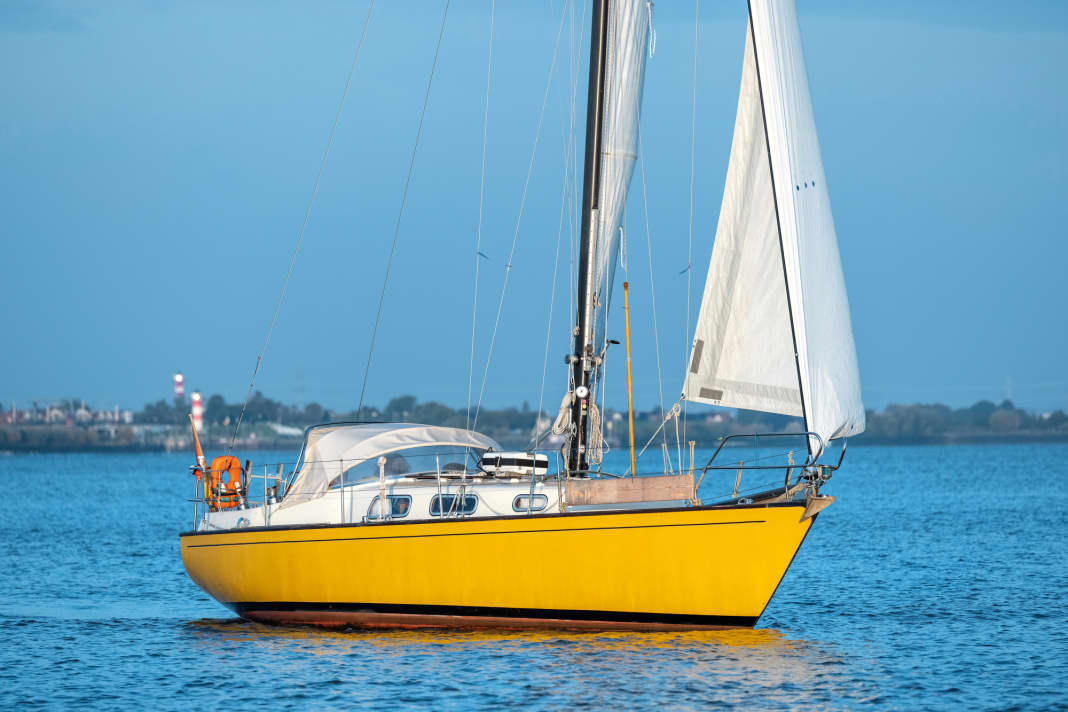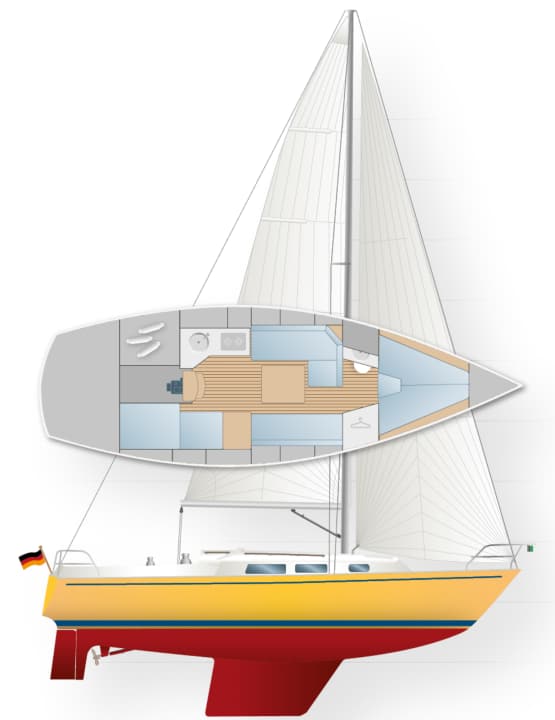





The tide and wind promise the best conditions for testing the Hornet from Wedel near Hamburg in the morning. With light winds of up to ten knots at the start, the Hornet cruises up the Elbe, but the outgoing water means that the harbour entrance is permanently abeam.
This showed that the genoa cannot be hoisted properly: Although the rail with the hoisting point is positioned on the Hornet's superstructure, the headsail then gets caught on the outer upper shroud and cannot be sheeted so tightly. One solution seems to be to lead the sheet inside the upper shrouds and outside around the lower shrouds. The only slightly overlapping Genoa II can thus be hauled closer and does not touch the top of the spreader. Later on, however, this sheet guide was disadvantageous on a rough course, as the headsail could not be furled as desired and was extremely bulbous. A practical solution has to be found here - constantly changing the sheet guide is very time-consuming.
Hornet 32 is also made for harsher conditions
Apart from that, the boat, which was built in 1975, sails well, picking up speed a little sluggishly but steadily. Particularly in the strong gusts of up to 25 knots, the Hornet proves that it can cope well with more wind and never gets hectic. Even when she heels up to 20 degrees - as soon as the boat is under way, she sails very upright again. It conveys a great deal of safety. The tiller provides good feedback without too much pressure. However, the fitting that connects the tiller and rudder shaft has some play. Upwind, the log shows 4.5 knots, the tacking angle is around 90 degrees - solid values.
To avoid the strong tidal current, we change course and sail behind the Hanskalbsand. The wind picks up and the log shows a speed of up to 6 knots. Especially in the gusts, it becomes clear that the Hornet is made for relaxed sailing even in rougher conditions thanks to its relatively high weight and low ballast. After all, the Elbe and North Sea are the area for which Helmut Hatecke once designed her. The shipyard in Drochtersen still exists, but no longer produces pleasure craft - the company is now one of the market leaders for free-fall lifeboats. In the 1960s, the shipyard switched production from wood to GRP, and the shipyard boss at the time designed a number of sailing yachts that caused a sensation with their seaworthiness and outstanding build quality.
Used boat profile Hornet 32
- Type: Hornet 32
- Design engineer: Helmut Hatecke
- Built by: 1972 to 1983
- Quantity: 50
- New price (1975): 98,000 DM
- Used price current: from € 25,000
Practical and beautiful details on deck
A cursory glance over the deck and superstructure shows that this reputation was justified. The gelcoat surfaces shine almost as good as new, and there is no sign of a yacht built in 1975. On closer inspection, there are also no cracks or signs of fatigue to be found on the deck mouldings and railing supports. And the anti-slip surface moulded into the deck is also still quite grippy. It is certainly more durable than any teak deck and is preferable to wooden decking on a used boat of this age. Because even if a wooden deck is beautiful, today it would be a costly construction site.
The cockpit offers plenty of space but, as you would expect from a boat of this era, it is narrow enough to be able to lean against the opposite bulwark when the boat is in position. Unfortunately, there is no room to sit on the coaming between two pairs of (non-self-tailing) winches and the associated clamps. The mainsheet is led to the bridge deck, allowing freedom of movement in the cockpit. It is necessary to go to the mast to set the sails; halyards and outhauls are not redirected aft under the sprayhood.
Lots of wood, classic layout below deck
The very good impression continues below deck. The woodwork is simple but of high quality. The teak veneer surfaces have a very ship-like appearance, albeit somewhat dark. Overall, however, the saloon is very cosy. With a design that is almost 50 years old, an aft cabin is not to be expected even on a 32-footer. The only living space under the cockpit is a dog bunk to starboard aft of the chart table. But there is plenty of storage space. All seat thwarts can be opened up. Many metres of rubber sealant need to be checked regularly, otherwise the six locker lids will become a gateway for rainwater.
The forward berth is cosy, but at 187 centimetres long it is not generously dimensioned. The shoulder width of just under 170 centimetres, on the other hand, is very good. The toilet is installed on the port side between the saloon and the forward berth. The door to the berth and the opposite cupboard form the toilet room. At 121 by 69 centimetres, it is not particularly large, but it is sufficient. As part of the forward hatch extends into the bathroom, it can also be well ventilated. The washbasin, which can be moved on rails, is pulled out from under the toilet cabinet above the toilet. The galley is located on the port side, close to the companionway. It is arranged in an L-shape and equipped with two sinks and a two-burner hob with oven installed at sea. Apart from the shelf above the hob, it does not offer much work surface. However, the 77.5 x 90.5 centimetre saloon table can be put to good use here.
Internal values of the Hornet 32
The interior fittings were not made by Hatecke, the hull of construction number 2363 was sold without them at the time, but then customised by a specialist for the first owner. Due to this practice, the quality of the Hornet's interior can generally vary and must always be assessed on a case-by-case basis.
There are no keel bolts under the floorboards. The medium-length keel fin is part of the hull shell and contains the water tank. The lead ballast is located in the lower third. The advantage of this design is the absence of the keel-hull connection, which could leak. In addition, the centre of gravity is very low, which ensures high rigidity. The rudder sits behind a solid skeg. The engine, as well as the entire installation on board, is carefully executed and leaves a very good impression.
A three-bladed SPW rotary blade propeller pushes under the engine. It takes a good two to three boat lengths to stop. A strong wheeling effect to port is noticeable when travelling astern. Manoeuvres require a high speed, especially astern, where at least 3 knots of speed are necessary to be able to steer accurately. However, if you take this peculiarity into account, even narrow pit lanes are no problem.
Pricing then and now
The Hornet 32 once cost almost 100,000 marks. The owners bought the test boat in 2021 for 25,000 euros. Hatecke built the Hornet 30, 32, 33 and 345 between 1963 and 1983. A total of 100 yachts were delivered, including almost 50 Hornet 32s. Anyone looking for this type of boat will certainly need to be patient. In return, however, you get a high-quality boat with very solid sailing characteristics and a cosy and usable interior. Typical problems of a second-hand boat such as leaking windows, chalked gelcoat, worn surfaces below deck or ageing installations could not be detected. On the contrary, everything makes a surprisingly good and functional impression. Only the navigation electronics could be replaced.
For a price of around 25,000 euros, you get a very high-quality boat that is also spacious for two people. As the Hornet is designed for tidal areas and can also be found there, the keel should always be checked for any grounding damage. Only the water tanks in the keel could become a problem. Cleaning is not easy due to the limited access, but it is not impossible.
The measured values for testing the Hornet 32



The Hornet 32 in detail

Technical data of the Hornet 32
- Year of construction: 1975
- Total length: 9,72 m
- Waterline length: 8,10 m
- Width: 3,14 m
- Depth: 1,65 m
- Mast height above deck: 12,00 m
- Theor. torso speed: 6.9 kn
- Weight: 5,0 t
- Ballast/proportion: 2,3 t/46 %
- Mainsail: 17,6 m2
- Furling genoa (106 %): 35,0 m2
- Machine (Nanni): 21 kW/29 hp
- Fuel tank (diesel): 147 l
- Fresh water tank: 210 l
- Holding tank: -
Hull and deck construction
Solid laminate, hand lay-up with isophthalic polyester resin. In the underwater hull area with inner shell, in which the cradles, dents and the engine foundation are moulded
Structure
Test boat with a spacious touring superstructure in the foredeck. Alternatively, there was a sloping cabin that ended just before the mast on deck
Rig
Top rig with a pair of spreaders and double lower shrouds. Upper shrouds attached on the outside, lower shrouds on the inside (passageway). Halyards are operated on the mast
Engine
Originally with Volvo Penta MD 2 B (25 hp), alternatively Farymann diesel (20 hp). The test ship already had its second engine, Nanni (29 hp)
Price and shipyard
Equipment and prices
- Base price 1975: 98,000 DM
- Price ready to sail:100,900 DM
- Price used: from € 25,000
Shipyard
Hatecke, Drochtersen; www.hatecke.de
YACHT rating of the Hornet 32
The Hornet is still in top form after almost half a century. The gelcoat looks excellent and there is a Hallberg-Rassy feeling below deck. The fittings are high quality and cosy
Design and concept
- + Seaworthy cruising boat
- + Sturdy, high-quality construction
- + No keel-hull connection
Sailing performance and trim
- + Solid values, secure feeling
- + Very direct control
- - Starts off rather sluggishly
Living and finishing quality
- + Beautiful woodwork
- + Plenty of storage space
- - Quite dark below deck
Equipment and technology
- + Self-tacking jib as standard
- + Rolling system from Reckmann
- - Traps are operated at the mast
The article first appeared in YACHT 06/2022 and has been updated for the online version.

